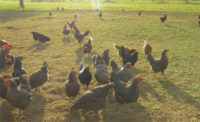Animal rights activists will latch onto just about anything animal agriculture-related that they think can be used to further their agenda. It’s no surprise that activists have continually focused on animal welfare and the manner in which animals are being raised. While most animal caretakers follow species-specific animal welfare guidance developed by research committees and backed by science, activist groups continue to push for stricter production practice mandates that they feel are best for the animals – even though research has proved time and time again that it is not. Ultimately, their true intention is to reduce efficiency and drive up the cost of raising animals in hopes that they will eventually reach their end goal of eliminating animal agriculture.
Pressure campaigns are frequently ignited by animal rights groups to force these changes on the animal agriculture community. These campaigns are used to coerce farms, processing plants, distributors, restaurants, retailers, and any link in the food supply chain to adhere to their demands. And while many times these groups are ruthless and appear to make a lot of noise, they are typically only heard within their own activist circles.
One tactic used in pressure campaigns is the push for “incremental changes” in animal welfare practices. This tactic makes groups appear less extreme and is used as a stepping stone to eventually advocate for even more dramatic changes in how animals are raised. We saw this happen with the laying hen community when activist groups pushed for cage-free eggs before arguing now that “cage-free” does not go far enough to protect the well-being of the hens.
In the broiler chicken community, these groups are pressuring suppliers, restaurants, retailers and foodservice brands to adhere to the Better Chicken Commitment. Several high-profile animal rights groups are behind this initiative, including the American Society for the Prevention of Cruelty to Animals (ASPCA), Humane Society of the United States (HSUS) and Mercy for Animals. The Better Chicken Commitment has two versions, but both include adherence to Global Animal Partnership (GAP) standards, which are always subject to change and may evolve beyond what food companies originally committed to. It’s important to note that GAP may appear to be an organization looking out for the best interest of the animals, but it is highly influenced and directed by animal rights groups – many of its current and former board members are leaders of various activist organizations.
Similarly, sow housing, and more specifically the use of gestation stalls, has also been a focus point for animal rights groups recently. Gestation stalls are primarily used to protect sows from others in the group as they can be very aggressive during pregnancy. Studies have also shown that when given the choice, sows prefer their individual stalls over group housing settings. Even so, animal rights groups continue to push food companies to support and adopt crate-free housing policies that eliminate this protection for sows. High-profile groups supporting this include those mentioned previously as well as Animal Legal Defense Fund (ALDF) and People for the Ethical Treatment of Animals (PETA).
Annual scorecards frequently released by activist groups claim to document food companies’ commitment and adherence to these demands. These reports are used to pressure these companies (and supporting organizations) to push for higher standards of animal welfare that align with practices the animal rights community condones. Recently, the 2020 Business Benchmark on Farm Animal Welfare report was released specifically to influence investors. The Benchmark uses publicly available documentation to determine a preliminary score for the food company. Once a preliminary score has been developed, Benchmark working group members reach out to the company inviting them to send written comments or request more information about the assessment. All of this is done in an attempt to pressure the company into adopting tougher animal welfare policies, despite what science has to say.
Processors serve as the middlemen between farms that supply the product and retailers who sell it, so you have a vested interest in the success of both ends of the supply chain. This means you are uniquely positioned to offer and share information to either side to ensure the food community as a whole is working together and understands the issues that either end is facing – issues such as activist pressure, animal welfare concerns, antibiotic use and sustainability. It’s important that the entire animal agriculture community works together to continue our goal of providing a responsible and sustainable food supply. As always, the Animal Agriculture Alliance team is available as a resource to engage in these conversations and to protect against animal rights activist activity.
For more information about the Animal Agriculture Alliance and its upcoming Virtual Stakeholders Summit, visit https://animalagalliance.org/.
Under Pressure: Animal rights groups continue to push animal welfare demands



